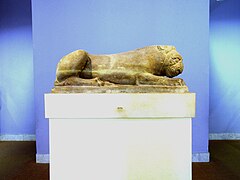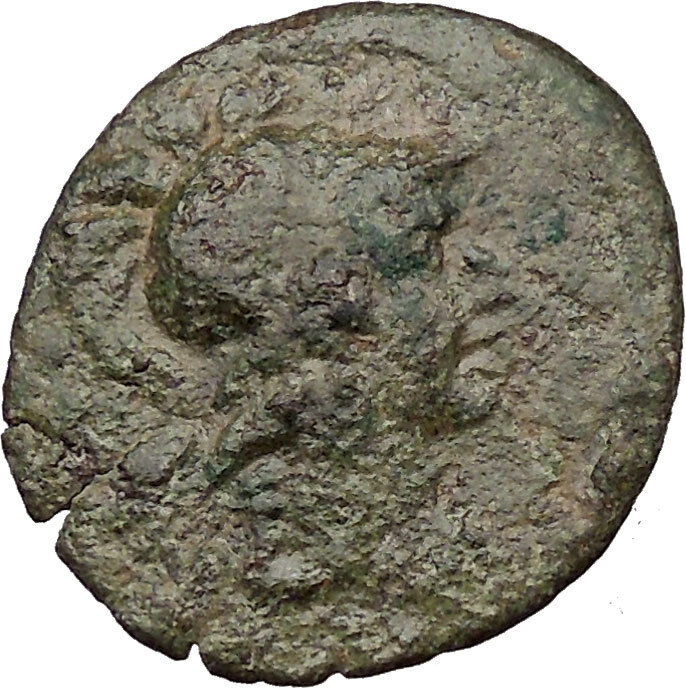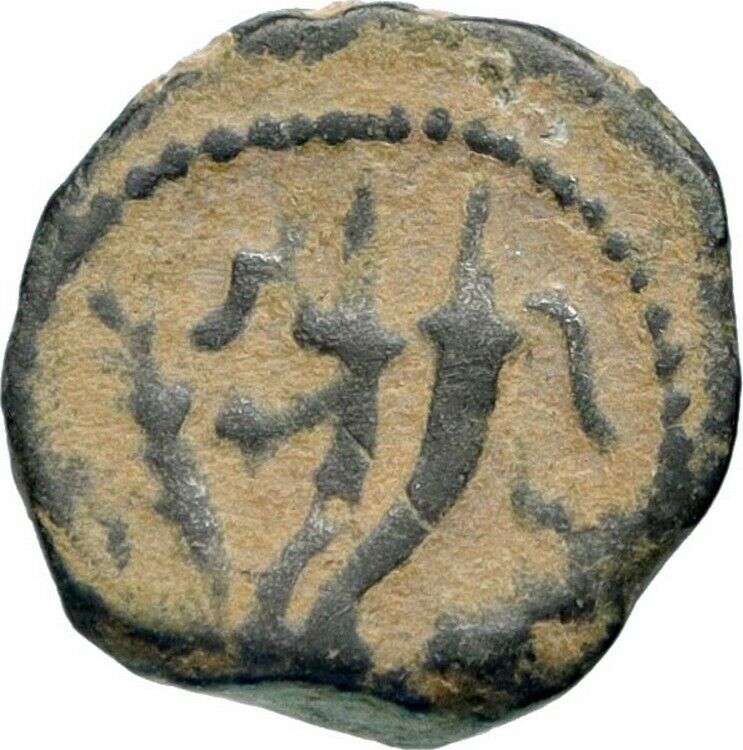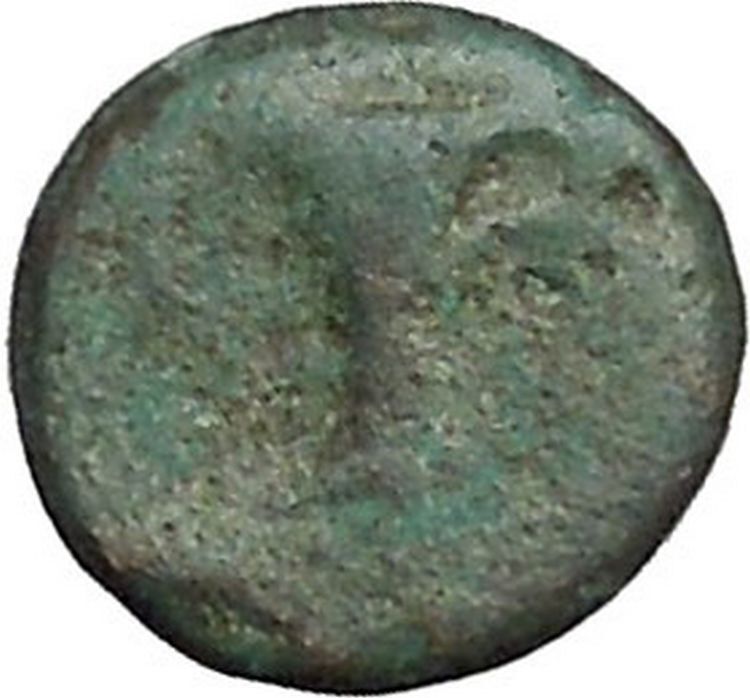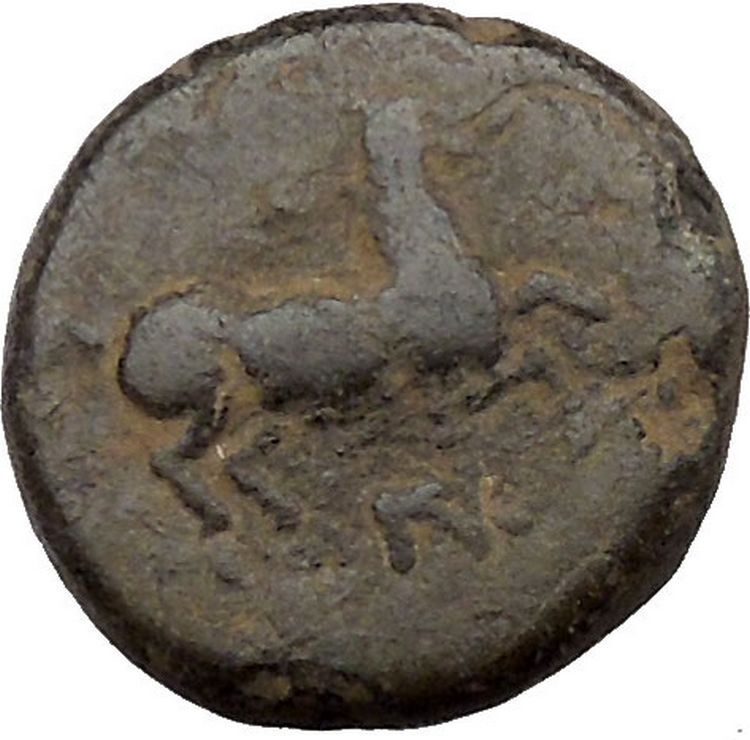|
Greek city of
Korkyra on island of Corfu off Epeiros
Bronze 17mm (6.52 grams) Struck circa 229-48 B.C.
Reference: HGC 6, 101; Sear 2049 var.
Head of young Dionysus right, wreathed with viy.
Kantharos surmounted by a bunch of grapes; K-O below.
You are bidding on the exact item pictured,
provided with a Certificate of Authenticity and Lifetime Guarantee of
Authenticity.
Dionysus
is the god of the
grape harvest, winemaking and wine, of ritual madness, fertility, theatre and
religious ecstasy in
Greek mythology
. Alcohol, especially
wine, played an important role in Greek
![2nd century Roman statue of Dionysus, after a Hellenistic model (ex-coll. Cardinal Richelieu, Louvre[1])](https://upload.wikimedia.org/wikipedia/commons/thumb/8/8a/Dionysos_Louvre_Ma87_n2.jpg/200px-Dionysos_Louvre_Ma87_n2.jpg)
culture
with Dionysus being an important reason for this life style. His name, thought
to be a theonym
in
Linear B
tablets as di-wo-nu-so (KH
Gq 5 inscription), shows that he may have been worshipped as early as c.
1500–1100 BC by
Mycenean Greeks
; other traces of the
Dionysian-type cult have been found in ancient
Minoan Crete
. His origins are uncertain, and
his cults took many forms; some are described by ancient sources as Thracian,
others as Greek. In some cults, he arrives from the east, as an Asiatic
foreigner; in others, from
Ethiopia
in the South. He is a god of
epiphany
, “the god that comes”, and his
“foreignness” as an arriving outsider-god may be inherent and essential to his
cults. He is a major, popular figure of
Greek mythology
and
religion
, and is included in some lists of the
twelve Olympians
. Dionysus was the last god to
be accepted into Mt. Olympus. He was the youngest and the only one to have a
mortal mother. His festivals were the driving force behind the development of
Greek theatre
. He is an example of a
dying god
.
The earliest cult images of Dionysus show a mature male, bearded and robed.
He holds a fennel
staff, tipped with a pine-cone and known
as a thyrsus
. Later images show him as a
beardless, sensuous, naked or half-naked androgynous youth: the literature
describes him as womanly or “man-womanish”. In its fully developed form, his
central cult imagery shows his triumphant, disorderly arrival or return, as if
from some place beyond the borders of the known and civilized. His procession
(thiasus)
is made up of wild female followers (maenads)
and bearded
satyrs
with
erect penises
. Some are armed with the
thyrsus, some dance or play music. The god himself is drawn in a chariot,
usually by exotic beasts such as lions or tigers, and is sometimes attended by a
bearded, drunken Silenus
. This procession is presumed to be the
cult model for the human followers of his
Dionysian Mysteries
. In his
Thracian
mysteries, he wears the bassaris
or
fox-skin, symbolizing a new life. Dionysus is represented by city
religions as the protector of those who do not belong to conventional society
and thus symbolizes everything which is chaotic, dangerous and unexpected,
everything which escapes human reason and which can only be attributed to the
unforeseeable action of the gods.
Also known as Bacchus, the name adopted by the
Romans
and the frenzy he induces, bakkheia.
His thyrsus is sometimes wound with ivy and dripping with honey. It is a
beneficent wand but also a weapon, and can be used to destroy those who oppose
his cult and the freedoms he represents. He is also called Eleutherios
(“the liberator”), whose wine, music and ecstatic dance frees his followers from
self-conscious fear and care, and subverts the oppressive restraints of the
powerful. Those who partake of his mysteries are possessed and empowered by the
god himself. His cult is also a “cult of the souls”; his maenads feed the dead
through blood-offerings, and he acts as a divine communicant between the living
and the dead.
In Greek mythology, he is presented as a son of
Zeus and the mortal
Semele
, thus semi-divine or
heroic: and as son of Zeus and
Persephone
or
Demeter
, thus both fully divine, part-chthonic
and possibly identical with
Iacchus
of the
Eleusinian Mysteries
. Some scholars believe
that Dionysus is a
syncretism
of a local Greek nature deity and a
more powerful god from
Thrace
or
Phrygia
such as
Sabazios
or
Zalmoxis
.

A
kantharos or cantharus is a type of
Greek pottery
used for drinking. In its iconic
“Type A” form, it is characterized by its deep bowl, tall pedestal foot, and
pair of high-swung handles which extend above the lip of the pot. The Greek
words kotylos (κότῦλος, masculine) and kotyle (κοτύλη, feminine)
are other ancient names for this same shape.
The kantharos is a cup used to hold
wine, possibly for drinking or for
ritual
use or
offerings
. The kantharos seems to be an
attribute of
Dionysos
, the god of wine, who was associated
with
vegetation
and
fertility
.
It may not be a banquet-cup, but rather a vessel used in pagan cult as a
symbol of
rebirth or resurrection
, the
immortality
offered by wine, “removing in
moments of ecstasy the burden of self-consciousness and elevating man to the
rank of deity.”
Korkyra (also Corcyra,
Greek
: Κόρκυρα)
was an ancient Greek city on the island of
Corfu
in the
Ionian sea
, adjacent to
Epirus
. It was a colony of
Corinth
, founded in the archaic period.
According to
Thucydides
, the earliest recorded naval battle
took place between Korkyra and Corinth, roughly 260 years before he was writing
– and thus in the middle of the seventh century BC. He also writes that Korkyra
was one of the three great naval powers in fifth century BC Greece, along with
Athens
and Corinth.

Kerkyra municipal unit (Dimotiki enotita Kerkyreon) within the
island.
The antagonism between Korkyra and its mother city Corinth appears to have
been an old one. Quite apart from the naval battle Thucydides talks of,
Herodotus
records a myth involving the
tyrant
of Corinth,
Periander
. Periander was estranged from his
younger son,
Lycophron
, who believed that his father had
killed his mother Milissa. After failing to reconcile with Lycophron, he sent
him to Korkyra, then within Corinth’s governance. In his old age, Periander sent
for his son to come and rule over Corinth, suggesting that they would trade
places and he would rule Korkyra while his son came to rule Corinth. To prevent
this, the Korkyraeans killed Lycophron. In punishment, Periander captured 300
young men of Korkyra with the intention of castrating them. This is more likely
to be a myth explaining the animosity between Corinth and Korkyra (and
justifying the use of the word tyrant for Periander’s rule) than an
actual historical event.
The Persian War
In the
Persian War
of 480 BC, Greek envoys were sent
to Korkyra requesting aid. Korkyra enthusiastically promised ships, and fitted
out sixty of them, but they failed to arrive in time for the
battle of Salamis
.
Herodotus
credits this as a desire among the
Korkyraeans to remain neutral and thus not support the losing side. The excuse
given for failing to join the battle was unfavourable winds, whereas Herodotus
says that, had the Persians been victorious, the Korkyraeans would have claimed
to have deliberately avoided the battle and, thereby, gain favour from the
invading Persians.
The Peloponnesian War
Writing between 431 and 411 BC, Thucydides credited Korkyra’s conflict with
Corinth over their joint daughter-city
Epidamnus
as a significant cause of the
Peloponnesian War
. Korkyra, otherwise neutral
as far as the two major powers, the
Delian League
and the
Peloponnesian League
, were concerned, appealed
to Athens, head of the Delian League, for assistance against Corinth, who
belonged to the Peloponnesian League.
In 427 BC, during the Peloponnesian War, there was a civil war in Korkyra
between the democrats, who wished to remain in an alliance with Athens, and the
aristocrats, who claimed that they were being enslaved to Athens and wished to
form an alliance with Corinth. The democrats won with help from Athenian ships,
and subsequently slaughtered anyone they suspected of being an enemy.
The Fourth Century BC
Around 375 BC, a Peloponnesian fleet, under the command of
Mnesippus
, attacked Korkyra. Following the
siege, the resident Korkyraeans, suffering from hunger, deserted, were sold as
slaves or, later, put to death by Mnesippus.
The Hellenistic Era
In the
Hellenistic Period
Corcyra changed hands
several times. In 303 BC, after a vain siege by
Cassander
of
Macedon
, the island was occupied for a short
time by the Lacedaemonian
general
Cleonymus of Sparta
, then regained its
independence. Three years on Cassander besieged it again, but his fleet was
destroyed by an intervention of
Agathocles of Syracuse
. The
tyrant
of
Syracuse
added the island to his own domains
and in 295 BC he offered it as dowry to his daughter
Lanassa
on her marriage to
Pyrrhus
, King of
Epirus
. When Lanassa left Pyrrhus in 291 BC she
tried to pass her place on her next husband, king
Demetrius Poliorcetes
of
Macedon
, but in 274 BC Pyrrhus’ son
Ptolemy
recovered Corcyra for his father.
Corcyra remained a member of the
Epirote League
until 255 BC when it regained
independence after the death of
Alexander II
, last King of Epirus. In 229 BC,
following a Greek defeat in the naval
battle of Paxos
, the city suffered a
short-lived occupation by
Illyrians
under the command of
Demetrius of Pharos
. The
Roman Republic
intervened almost immediately,
sending one of the consuls to relieve the island. At the end of the
First Illyrian War
Korkyra was declared a free
city and transformed into a Roman
protectorate
, de facto ending the independence
of the polis. Around 189 BC it was governed by a Roman prefect (presumably
nominated by the consuls), and in 148 BC it was attached to the province of
Macedonia
.
Corfu is a
Greek
island
in the
Ionian Sea
. It is the second largest of the
Ionian Islands
, and, including its small
satellite islands, forms the edge of the northwestern frontier of Greece. The
island is part of the
Corfu regional unit
, and is administered as a
single municipality. The municipality includes the island of Corfu and the
smaller islands of
Ereikoussa
,
Mathraki
and
Othonoi
. The principal city of the island and
seat of the municipality (pop. 32,095) is also named
Corfu
. Corfu is home to the
Ionian University
.
The island is bound up with the
history of Greece
from the beginnings of
Greek mythology
. Its Greek name, Kerkyra
or Korkyra
, is related to two powerful water
symbols: Poseidon
, god of the sea, and
Asopos
, an important Greek mainland river.
According to myth, Poseidon fell in love with the beautiful nymph Korkyra,
daughter of Asopus and river nymph
Metope
, and abducted her. Poseidon brought
Korkyra to the hitherto unnamed island and, in marital bliss, offered her name
to the place: Korkyra, which gradually evolved to Kerkyra (Doric).
Together, they had a child they called Phaiax, after whom the inhabitants
of the island were named:
Phaiakes
. This term was transliterated via
Latin
to Phaeacians. Corfu’s nickname is The
island of the
Phaeacians
.
The island’s history is full of battles and conquests. Castles punctuating
strategic locations across the island are a legacy of these struggles. Two of
these castles enclose its capital, which is the only city in Greece to be
surrounded in such a way. As a result, Corfu’s capital has been officially
declared a Kastropolis (“castle city”) by the Greek government. From
medieval times and into the 17th century, the island was recognised as a bulwark
of the European States against the
Ottoman Empire
and became one of the most
fortified places in Europe. The fortifications of the island were used by the
Venetians to defend against Ottoman intrusion into the
Adriatic
. Corfu repulsed several
Turkish
sieges, before falling under British
rule following the
Napoleonic Wars
. Corfu was eventually ceded by
the British Empire along with the remaining islands of the
United States of the Ionian Islands
, and
unification with
modern Greece
was concluded in 1864 under the
Treaty of London
.
In 2007, the city’s old quarter was added to the
UNESCO
World Heritage List
, following a recommendation
by
ICOMOS
.
Corfu is a very popular tourist destination. The island was the location of
the
1994 European Union summit
.
Early history
A relief of
Dionysus
Bacchus at the
Archaeological Museum of Corfu
.
The earliest reference to Corfu is the
Mycenaean Greek
word ko-ro-ku-ra-i-jo (“man
from Kerkyra”) written in
Linear B
syllabic script, c. 1300 BC. According
to Strabo
Corcyra (Κόρκυρα) was the
Homeric
island of
Scheria
(Σχερία), and its earliest inhabitants
were the
Phaeacians
(Φαίακες). The island has indeed
been identified by some scholars with Scheria, the island of the Phaeacians
described in Homer
‘s
Odyssey
, though conclusive and irrefutable
evidence for this theory or for
Ithaca
‘s location have not been found.
Apollonius of Rhodes
depicts the island in
Argonautica
as a place visited by the
Argonauts. Jason
and
Medea
were married there in ‘Medea’s Cave’.
Apollonius named the island Drepane, Greek for “sickle”, since it was
thought to hide the sickle that
Cronus
used to castrate his father
Uranus
, from whose blood the Phaeacians were
descended. In an alternative account, Apollonius identifies the buried sickle as
a scythe belonging to
Demeter
, yet the name Drepane probably
originated in the sickle-shape of the island. According to a
scholiast
, commenting on the passage in
Argonautica, the island was first of all called
Macris
after the nurse of
Dionysus
who fled there from
Euboea
.
Other have asserted that Corfu was
Taphos
, the island of the
lelegian
Taphians.
At a date no doubt previous to the foundation of
Syracuse
, Corfu was peopled by settlers from
Corinth
, probably 730 BC, but it appears to
have previously received a stream of emigrants from
Eretria
. The commercially advantageous location
of Corcyra on the way between Greece and
Magna Grecia
, and its fertile lowlands in the
southern section of the island favoured its growth and, influenced perhaps by
the presence of non-Corinthian settlers, its people, quite contrary to the usual
practice of Corinthian colonies, maintained an independent and even hostile
attitude towards the mother city.
The ruins of the Temple at Kardaki, built about 700 BC
This opposition came to a head in the early part of the 7th century BC, when
their fleets fought the first naval battle recorded in Greek history: 665 BC.
according to
Thucydides
. These hostilities ended in the
conquest of Corcyra by the Corinthian tyrant
Periander
(Περίανδρος) who induced his new
subjects to join in the colonization of
Apollonia
and
Anactorium
. The island soon regained its
independence and henceforth devoted itself to a purely mercantile policy. During
the
Persian
invasion of 480 BC it manned the second
largest Greek fleet (60 ships), but took no active part in the war. In 435 BC it
was again involved in a quarrel with
Corinth
over the control of
Epidamnus
, and sought assistance from Athens
(see
Battle of Sybota
).
This new alliance was one of the chief immediate causes of the
Peloponnesian War
, in which Corcyra was of
considerable use to the
Athenians
as a naval station, but did not
render much assistance with its fleet. The island was nearly lost to Athens by
two attempts of the oligarchic faction to effect a revolution; on each occasion
the popular party ultimately won the day and took a most bloody revenge on its
opponents (427 BC and 425 BC).
The lion of Menekrates at the
Archaeological Museum of Corfu
During the Sicilian
campaigns of Athens Corcyra served as
a supply base; after a third abortive rising of the oligarchs in 410 BC it
practically withdrew from the war. In 375 BC it again joined the Athenian
alliance; two years later it was besieged by a
Spartan
force, but in spite of the devastation
of its flourishing countryside held out successfully until relieved. In the
Hellenistic
period Corcyra was exposed to
attack from several sides.
In 303 BC, after a vain siege by
Cassander
, the island was occupied for a short
time by the
Lacedaemonian
general
Cleonymus of Sparta
, then regained its
independence and later it was attacked and conquered by
Agathocles
. He offered Corfu as dowry to his
daughter
Lanassa
on her marriage to
Pyrrhus
, King of
Epirus
. The island then became a member of the
Epirotic alliance. It was then perhaps that the settlement of
Cassiope
was founded to serve as a base for the
King of Epirus’ expeditions. The island remained in the Epirotic alliance until
255 BC when it became independent after the death of
Alexander
, last King of Epirus. In 229 BC,
following the naval
battle of Paxos
, it was captured by the
Illyrians
, but was speedily delivered by a
Roman
fleet and remained a Roman naval station
until at least 189 BC. At this time, it was governed by a prefect (presumably
nominated by the consuls), but in 148 BC it was attached to the province of
Macedonia
. In 31 BC, it served
Octavian
(Augustus) as a base against
Mark Antony
. From AD 336 onwards, it was ruled
by the Eastern Roman Empire. After the definitive division of the Roman Empire
in AD 395, Kerkyra remained with the Eastern Roman Empire, known in modern
historiography as the
Byzantine Empire
.
|




![2nd century Roman statue of Dionysus, after a Hellenistic model (ex-coll. Cardinal Richelieu, Louvre[1])](https://upload.wikimedia.org/wikipedia/commons/thumb/8/8a/Dionysos_Louvre_Ma87_n2.jpg/200px-Dionysos_Louvre_Ma87_n2.jpg)




